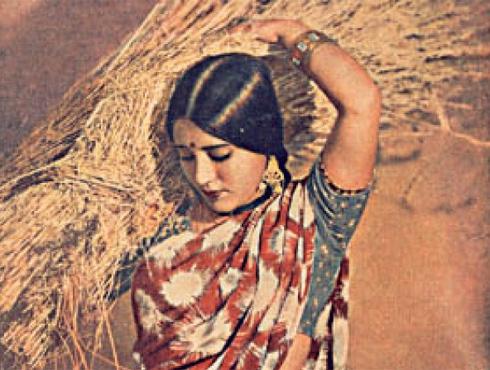Indian cinema: 1930-39
Contents |
Indian cinema: 1930-39
Title and authorship of the original article(s)
|
Brief history of Indian cinema By UrooJ, aligarians.com, mid-2000 |
Bollywood Cinema By h2g2, mid-2000 |
This is an article selected for the excellence of its content. |
1930
1930 : Sailajananda Mukherjee starts the Bengali film weekly Bioscope reporting on the Hollywood, Bombay and Calcutta film industries and publishing reviews, pre-release synopses of films, industrial surveys and occasionally essays about technical and aesthetic issues. Ambalal Patel and Chimanlal Desai start Sagar Film. Gubbi Veeranna starts production with the Gubbi-Karnataka Films Corporation at the Malleshwaram Studios in Bangalore. First Film society in India known as Punjab Cinema Art Society.
1931 : Alam Ara is India’s first sound film. B.N. Sircar founds New Theatres. Several Madan Theatres productions follow in quick successions with vastly superior sound systems. Pancholi’s Empire Talkie Distributors acquires rights to RKO - Radio productions and RCA - Photophone sound equipment. The Bengali film weeklies Chitralekha and Batayan and literary quarterly Parichay start.
1932 : First sound feature in Gujarati (Narasinh Mehta). The East India film Co. starts in Calcutta pioneering Bengali, Tamil and Telegu filmmaking. The Motion Picture Society of India (MPSI) is set up to represent the Indian Film Industry. Hindi weekly Cinema Sansar launched in Bombay. In Bengal the monthly Chitrapanji includes serious essays by filmmakers.
1933 : Prabhat Studio moves to Pune. Its Sairandhri processed and printed in Germany becomes India’s first colour film. Kolhapur Cinetone is started. Wadia Movietone is founded. Vijay Bhatt and others start Prakash Pictures. Vel Pictures and Tamil Nadu talkies are launched in Madras. Himanshu Rai’s Karma is premiered in London. The air - conditioned Regal cinema opens in Bombay.
1934 : Bombay Talkies is established by Himansu Rai and Devika Rani. East India Film Company’s Seeta directed by Debaki Bose is shown at Venice Film Festival. First sound features in Oriya (Seeta Bibaha) and Kannada (Bhakta Dhruva). Seeta Kalyanam made by Vel Pictures is the first sound feature made in Madras. Ranjit Studio’s Toofan Mail is the Hindi Cinema’s first major success in the stunt film genre. Hindi film periodical Chitrapat is launched in Delhi. Bengali film weekly Ruprekha starts.
1935 : First All-India Motion Picture Convention is held. New Theatres Devdas directed by P.C. Barua becomes reference point in Hindi and Bengali Cinema. New Theatres’ Dhoop Chaon establishes playback singing. Launch of the seminal film monthly Filmindia. The Quetta earthquake takes place on May 21. Its after effects are filmed by P.V. Pathy. First films in Punjabi (Sheila) and Assamese (Joymati). Madras United Artisits started at Salem. First Trade journal started by Motion Picture Society of India.
1936 : Amar Jyoti is shown in Venice. Master Vinayak and cameraman Pandurang Naik co-found Huns Pictures. Jaddanbai starts Sangeet Films with films featuring her daughter Nargis as a child artiste. Sohrab Modi and Rustom Modi start Minerva Movietone. The Bengal Motion Picture Association is formed in Calcutta. The second All-India Motion Picture Convention held at Madras. Ardershir Irani sets up cinecolour process laboratory with Wolf M. Henius as chief technician.
1937 : Indian Motion Picture Producers Association (IMPPA) founded in Bombay. Sant Tukaram receives special jury mention at Venice Film Festival. Imperial Film Company releases colour film Kisan Kanya using Cinecolour process. First songless film - J.B.H. Wadia’s Naujawan. The Amateur Cine Society of India formed in Bombay by P.V. Pathy, Stanley Jepson and Rudi Van Leyden. Bengali Film weekly Kheyali founded.
1938 : South Indian Film Chamber of Commerce formed in Madras. Indian Motion Picture Distributors Association set up in Bombay. Duniya Na Mane ( 1937) shown in Venice. Bombay Talkies makes probably the first officially commissioned ad film on Lever’s Dalda cooking oil for the Lintas Advertising Agency. The first Malayalam sound film, Balan. The Indian Screen Gazette is started by Wadia Movietone. P.V. Pathy films a three-reeler on the Haripura Congres for the Gazette.
1939 : Indian Film Industry celebrates its silver jubilee and holds Indian Motion Picture Congres in Bombay bringing together allied unions and trade associations to discuss problems. Vauhuni Pictures is started by B.N. Reddy and Gemini by S.S. Vasan. Film Industry, a trade newspaper is started in Bombay.
Kannada films
Year/ Movie (in Kannada)/ Director/ Cast/ Music Director/ Producer/ Banner
1934 Sati Sulochana (ಸತಿ ಸುಲೋಚನ) Y. V. Rao Nagendrarao, Subbaiah Naidu, Lakshmi Bai, Tripuraamba, C.T.Sheshachalam R.Nagendra rao Sha Chamanlal Dungaji South India Movitone
1934 Bhakta Dhruva (ಭಕ್ತ ಧೃವ) Paarshvanathah Aaltekar Master Muthu, T.Dwarakanath, H.S.Krishnaswamy Iyengar, G.Nageshrayaru, M.G.Marirao, T.Kanakalakshmama Harmonium Sheshagirirao Dr.Y.L. Narayana Rao Jayavani Talkies
1935 Sadaarame (ಸದಾರಮೆ) Rajaa Chandrashekar Gubbi Veeranna, Muraaraachaar, Shakunthala, K.Ashawathamma, Swaranamma Venkataramaiah (Papanna) Gubbi Veeranna Shakunthala Films
1936 Samsara Nauka (ಸಂಸಾರ ನೌಕ) H.L.N.Simha B.R.Panthulu, M.V.Rajamma, S.K.Padma Devi, M.S.Madhavarao, Dikki Madavarao M.Madhavarao K.Nanjappa Devi Films T.Telangi
1936 Chiranjeeve (ಚಿರಂಜೀವಿ) K.P.Bhave Devudu, Sharada, Malavalli Sundaramma, Basavaraju Mansoor, R.S.Murthy, Narayanarao Harmonium Sheshagirirao Kyanarees Talkies
1937 Purandaradaasa (ಪುರಂದರದಾಸ) B.Chawan G.Krishnaswamy Iyengar, Tripuraamba, J.T. Balakrishnarao, Devi Films
1937 Rajasuya Yaaga (ರಾಜಸೂಯ ಯಾಗ) T.Dwarakanath S.R.Vasudevarao, T.K.Ramamurhty, K.R.Seetharam, T.Jayamma, T.Chandrashekar, Saroja Padmanabha shashtri Mysore Sound Studios
Malayalam films
Year/ Movie/ Director/ Cast/ Music Director/ Producer/ Banner
Marthanda Varma 1933 P. V. Rao C. V. Raman Pillai
Balan 1938 S. Nottani Sundaram Pillai A Muthukulam Raghavan Pillai K. K. Aroor, Alleppey Vincent, M. K. Kamalam

